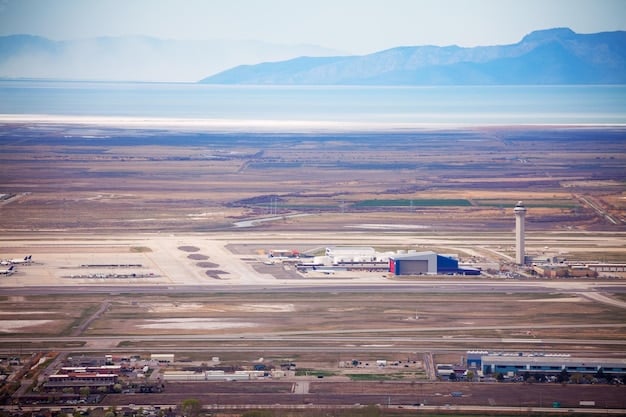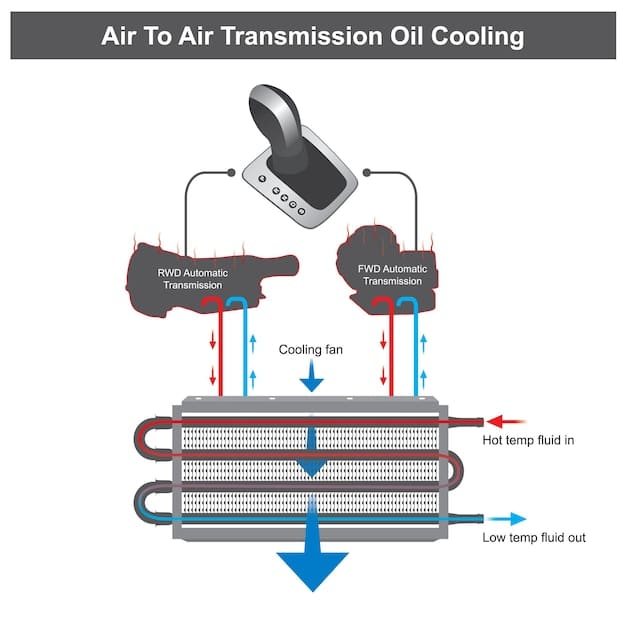Direct Air Capture: Can It Remove 10% of US Emissions by 2050?

Direct Air Capture (DAC) technology offers a promising solution for mitigating climate change by extracting carbon dioxide directly from the atmosphere; however, its potential to remove 10% of US carbon emissions by 2050 depends on significant technological advancements, policy support, and substantial investment.
Direct Air Capture (DAC) technology is gaining traction as a potential game-changer in the fight against climate change, but can this innovative approach really achieve the ambitious goal of removing 10% of US carbon emissions by 2050?
Understanding Direct Air Capture Technology
Direct Air Capture (DAC) represents a groundbreaking approach to mitigating climate change. Unlike traditional carbon capture methods that focus on capturing CO2 from point sources, DAC extracts CO2 directly from the ambient air. This distinction opens up possibilities for addressing historical emissions and deploying the technology virtually anywhere.
While the core principle is relatively straightforward, the process involves sophisticated engineering and chemical processes. Let’s delve into how this technology actually works.
The DAC Process: A Step-by-Step Overview
The DAC process typically involves the following key steps:
- Air Intake: Large fans draw ambient air into the DAC system.
- CO2 Capture: The air passes through a filter or contactor containing a chemical sorbent. This sorbent selectively binds with CO2 molecules, trapping them while allowing other air components to pass through.
- Sorbent Regeneration: Once the sorbent is saturated with CO2, it undergoes a regeneration process. This typically involves heating the sorbent to release the captured CO2.
- CO2 Collection and Utilization or Storage: The released CO2 is then collected in a concentrated form. It can then be used for various purposes, such as enhanced oil recovery (EOR), or permanently stored underground in geological formations.
Different DAC technologies exist, each employing unique sorbents and regeneration methods. Some use solid sorbents, while others use liquid solvents. The choice of sorbent and regeneration method impacts the energy requirements and overall efficiency of the DAC process.

The development of more efficient and cost-effective sorbents and regeneration techniques is a crucial area of research and development in the DAC field.
In conclusion, Direct Air Capture offers a potentially transformative solution for removing CO2 directly from the atmosphere. The efficiency and affordability of DAC technology are key factors that will determine its widespread adoption and its ability to make a significant impact on climate change mitigation.
The Potential Impact of DAC on US Carbon Emissions
The lofty ambition of removing 10% of U.S. carbon emissions by 2050 with Direct Air Capture (DAC) is definitely within the realm of possibility. However, fully achieving this goal presents some substantial hurdles that need to be tackled head on.
Let’s examine the possibilities and challenges associated with this objective.
Quantifying the 10% Goal
To understand the scope of the 10% reduction target, it’s important to first establish a baseline. In 2021, the United States emitted approximately 4.9 billion metric tons of carbon dioxide. Ten percent of this quantity is 490 million metric tons. That’s the annual amount of CO2 that would need to be removed by DAC in order to achieve the stated target by 2050. Is that possible?
This leads to a core question: Is relying on DAC a cost-effective solution when alternative strategies may be cheaper and can achieve the same results?
Scaling Up DAC Capacity
Currently, DAC facilities are still in their early stages of development. The world’s largest operating DAC plant, located in Iceland, can remove approximately 4,000 tons of CO2 per year. To reach the 490 million ton target, the U.S. would need to build thousands of facilities scaled to that size. The scale itself presents enormous logistical and engineering challenges, which include:
- Location selection and land use.
- Manufacturing and installation of CO2-capture equipment.
- Sourcing enough sustainable energy to drive the CO2-capture process.
Successfully addressing these challenges is crucial to realizing the large-scale emission reduction goal.
In summary, the potential for Direct Air Capture to significantly reduce US carbon emissions hinges on overcoming substantial scaling and deployment challenges. The development of cost-effective DAC technologies and supportive policy frameworks are crucial for realizing the ambitious goal of removing 10% of US carbon emissions by 2050.
Technological Hurdles and Innovations in DAC
As Direct Air Capture technologies move closer to the forefront of carbon reduction conversations, it’s important to note several critical hurdles and ongoing trends in the innovation sector.
These advances in technology will make achieving real-world impact a greater possibility.
Energy Requirements
One of the most significant challenges facing DAC is its high energy demand. The process of capturing CO2 from ambient air and regenerating the sorbent requires substantial amounts of energy. This energy consumption can offset the carbon reduction benefits of DAC if the energy source is not clean.

Cost Reduction
The high cost of DAC is another significant barrier to widespread adoption. Current estimates suggest that capturing one ton of CO2 using DAC can cost hundreds of dollars. This high cost makes DAC less competitive compared to other carbon reduction strategies, such as renewable energy deployment and energy efficiency measures.
To address the cost challenge, researchers are focused on developing more efficient sorbents, optimizing the DAC process, and leveraging economies of scale through larger facilities. The development of modular DAC systems that can be easily deployed in various locations could also help to reduce costs by lowering transportation and construction expenses.
- Advancements in material science are yielding novel sorbents with higher CO2 capture capacities and lower energy requirements.
- Process optimization involves refining the design and operation of DAC systems to minimize energy consumption and maximize CO2 capture efficiency.
- Exploring innovative energy sources such as waste heat and concentrated solar power can further reduce the carbon footprint of DAC.
In conclusion, achieving significant carbon emission reductions through Direct Air Capture requires ongoing innovation and breakthroughs in energy efficiency, cost reduction, and sustainable energy integration. Overcoming these technological hurdles will be critical to unlocking the full potential of DAC as a climate change solution.
Policy and Investment Needed for DAC Deployment in the US
To achieve the ambitious target of decarbonizing 10% of US carbon emissions using DAC, policy and investments at the federal and state level are essential. Such policies can help to create the market demand and make the technology more economically attractive.
Here are some key areas in which policy and investment can play a role.
Government Incentives
One of the main ways to bring attention and development to DAC is through incentive programs, such as tax credits, grants, and subsidies. These policies can directly lower the cost of DAC facilities, increasing the rate of development and creating more operational sites.
A good illustration of the positive impact can be found in California’s Low Carbon Fuel Standard, which allows credit for projects that involve carbon capture and storage, which has encouraged the DAC deployment.
Carbon Pricing Mechanisms
Carbon pricing mechanisms, e.g. carbon tax or cap-and-trade systems, can create financial incentives for reducing carbon emissions. With a carbon price, companies are incentivized to adopt carbon mitigation technologies (like DAC) as to avoid paying the carbon tax, making DAC a more competitive option.
Public-Private Partnerships
Collaboration between different stakeholders, like government agencies, and private companies, can help to boost the development and scale up of DAC. They can provide the financial capital, and technical expertise, to bring DAC from a concept idea to fully operational facilities.
These are areas where strong leadership from the government and financial community can contribute to the development of DAC.
Environmental and Social Considerations
As DAC technology moves towards broader deployment, understanding its environmental and social implications is critical. These factors are vital to consider when accessing the technology’s overall sustainability and viability.
Potential concerns related to direct air capture include land use, water usage, and community impact. Let’s examine these concerns
- Land Use: DAC facilities may require a significant area of land to install the necessary equipment. This is of concern because it may lead to deforestation or loss of existing farmland.
- Water Usage: Some DAC technologies may involve a lot of water, which can exacerbate water scarcity issues.
- Community Impact: Construction and operation of a DAC system can have implications for local population.
Addressing issues of environmental and social concerns is key to realizing the potential benefit of DAC technology while minimizing its environmental footprint.
In conclusion, sustainable development of DAC will depend on complete assessment and management of environmental, social, and ethical considerations. With thorough planning, transparent execution, and active community participation, these negative effects can be reduced and help toward a more reliable and equitable climate future.
The Future of Direct Air Capture Technology
Looking forward, the future of Direct Air Capture (DAC) technology seems optimistic, with continuous technological advancements and increasing adoption possibilities. As the world is more focused on climate change and innovative solutions, DAC is going to play a more and more important role.
But what does the roadmap for DAC look like in the years to come?
Further Technological Advances
Research and development activities can address current challenges and improve DAC technology. This includes working on new materials and designs to increase the efficient CO2 capture and drop the consumption of power and overall cost.
Integration with Renewable Energy
Combining carbon capturing facilities with sources of green electricity, can reduce carbon footprint of the technology and ensure environmentally friendly and economically viable.
Policy and Regulatory Support
For DAC to really reach its full potential, it’s essential to have strong backing through carefully crafted regulations and policies. These actions ensure there’s market demand and also create an environment that encourages more spending and new ideas in this field.
In conclusion, Direct Air Capture is an innovative and a crucial element in the global fight against climate change. Through continuous advances, strong support through policy, and a dedication to socially conscious and ecologically friendly methods, DAC promises a vital part toward a more sustainable and low emission future.
| Key Point | Brief Description |
|---|---|
| 🌱 DAC Technology | Extracts CO2 directly from the air, unlike point-source capture. |
| 🎯 10% Goal by 2050 | Aims to remove 490 million tons of CO2 annually in the US. |
| ⚡ Energy Needs | DAC requires significant energy; renewable sources are essential. |
| 💰 Policy & Investment | Government incentives and private funding are crucial for DAC deployment. |
Frequently Asked Questions
▼
Direct Air Capture extracts carbon dioxide directly from ambient air using specialized filters. The captured CO2 is then stored underground or used in industrial processes.
▼
DAC can remove legacy carbon emissions, addressing overall levels of CO2 in the atmosphere and potentially reversing some consequences of climate change.
▼
High energy demands, substantial costs, and the need for appropriate disposal or utilization methods for captured CO2 are major challenges currently hindering DAC.
▼
Tax credits, carbon pricing mechanisms, and public-private partnerships can all play a role to incentivize DAC development and reduce financial barriers to DAC implementation.
▼
Achieving the removal of 10% of US emission by 2050 is an ambitious goal, so widespread deployment and continual tech advances are vital!
Conclusion
While Direct Air Capture technology: Can DAC Remove 10% of US Carbon Emissions by 2050? poses significant challenges, ongoing innovation, supportive policies, and strategic investments offer a path toward a cleaner, more sustainable future. The potential of DAC to contribute to a substantial reduction in US carbon emissions warrants continued exploration and development.





